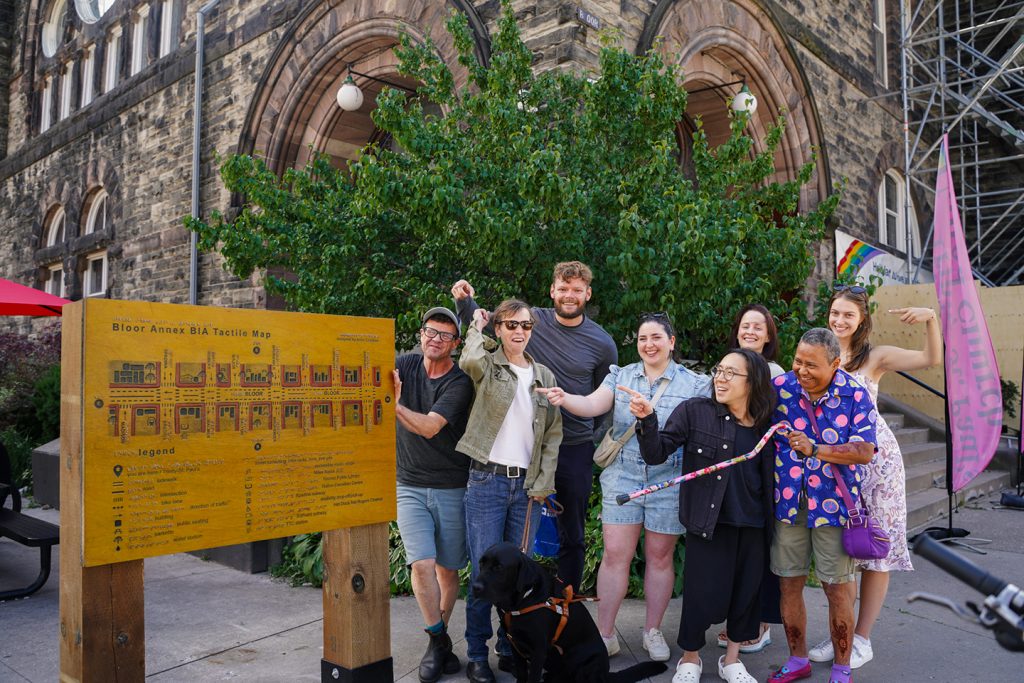Bloor Annex BIA and STEPS Public Art make the Annex more accessible

COURTESY AYESHA KHAN/STEPS PUBLIC ART
By Merideth Poirier
On Thursday, June 27, the Annex became a little more inclusive as it unveiled its new Tactile Map. The map sits on the corner of Bloor Street West and Robert Street, right next to Trinity-St. Paul’s Church at 427 Bloor St. W. The installation features braille writing and tactile symbols that allow for blind or low-vision individuals to read the map and navigate the neighbourhood more safely. Representatives from the Bloor-Annex Business Improvement Area (BIA) and STEPS Public Art, as well as local community members, were all present to reveal this novel guide. It is the first of its kind in North America and is a testament to the BIA’s focus on inclusivity and safety. Other accessible art spaces in the neighbourhood include the Bloor- Annex BIA stage (on the corner of Bloor Street and Brunswick Avenue) and Interconnections (an Indigenous mural) at Paul Martel Park. The bike lanes on Bloor were also a way to make the street more inclusive and safer, and the Bloor-Annex BIA was a major sponsor of them.
The Tactile Map project was years in the making. STEPS is a Canadian charity that connects artists to communities with an aim to make public spaces more welcoming and safer. In 2022, they approached the BIA to ask them to participate in an inclusive art project, as they had received funding to do so. “We’d worked with them [before] on a few other projects, so they thought of us and so we took on this accessibility [art project],” explained Melanie Ramsay, project coordinator for the BIA.
According to Madison Kennedy, project organizer for the Tactile Map initiative, they started by reaching out to Alex Bulmer (a blind Canadian artist) and ReDefine Arts about the process of creating a map with braille writing. This kind of map, to be installed outdoors, was a completely new concept for the organizers so they wanted to make sure that the proper approach was taken. After speaking with Bulmer and ReDefine Arts, Kennedy and Ramsay reached out to organizations that work with individuals with disabilities, as well as community members from various backgrounds. “We wanted to have a variety of different disabilities heard, but also a variety of different backgrounds. So, we had artists, we had urban planners, we had people from different disciplines come together to chat with Alex specifically,” explained Kennedy. Once these connections were made, Bulmer took individual walks with people, and they chatted on their walks and discussed challenges they encountered (as well as the positive aspects of the walk as well). These walks with Bulmer were recorded, and from them, audio tours of the walks were created. The audio tours can be accessed on the BIA’s website, and the hope is that they provide members of the neighbourhood with new ways to engage with the streets of the Annex. The audio tours are a part of Bulmer’s portfolio and are entitled May I Take Your Arm. The Tactile Map was a natural next step from the audio tours.
The creation of the map takes inspiration from Bulmer’s work and was created by artist Anna Camilleri. The map is a 48 by 32-inch exterior tactile map, mounted vertically on robust posts installed by the BIA. Featuring braille writing and tangible symbols for those who are blind or living with sight loss, the map assists individuals with navigating their neighbourhood safely.
Ramsay notes that the map is not perfect, and the BIA will continue to learn and improve it, as well as other accessible art features in the community. “Our Tactile Map is a pioneering prototype, the first of its kind for any business improvement area in North America. As a groundbreaking initiative, it represents an important step towards creating more accessible awareness in public spaces,” said Ramsay.
The BIA will continue to have conversations with community members, artists, and individuals with disabilities in order to make the guide more useful and as safe as it can be.
